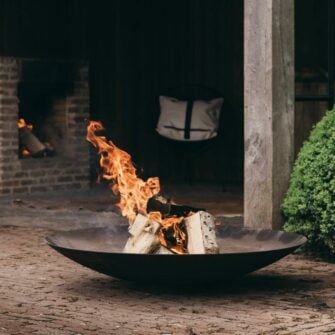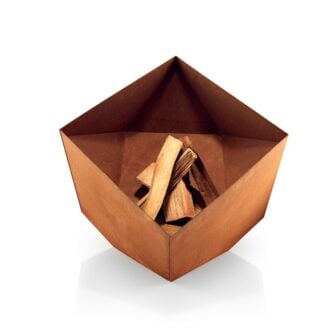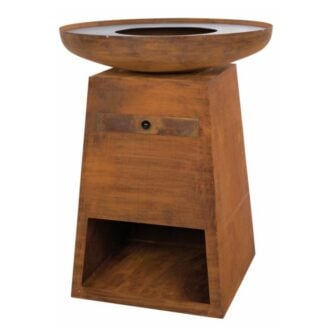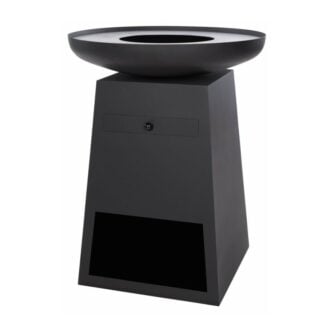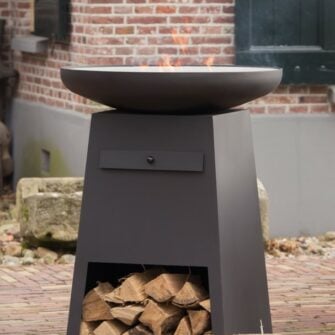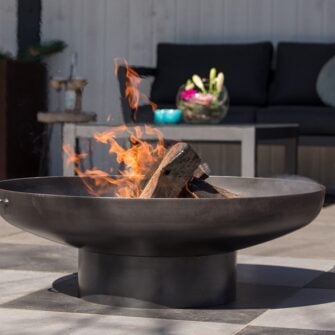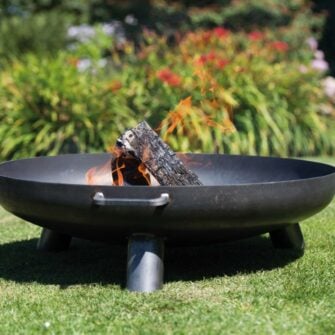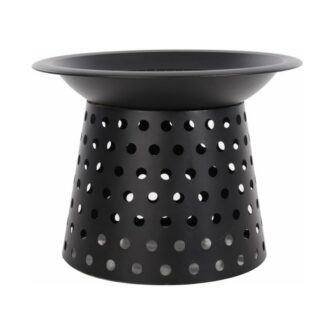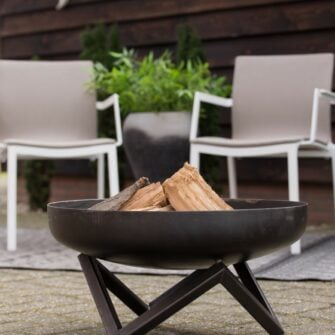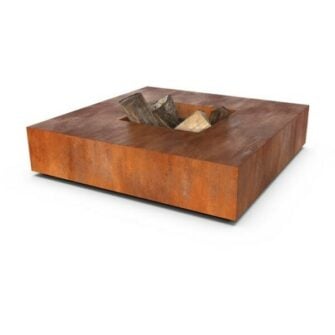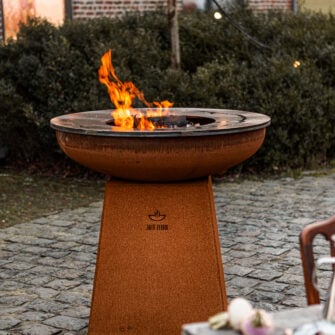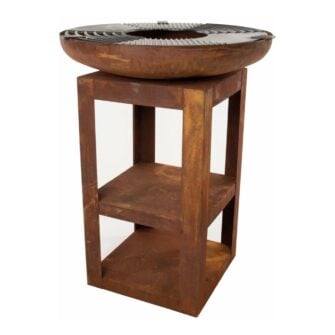A fire bowl in the garden creates a cozy atmosphere, blissful warmth and a beautiful flame.
Overview of the fire bowls info
Which fire bowl should you choose?
We list the different types for you.
There are many different shapes and sizes. Usually fire bowls are made of powder coated steel or Corten steel and often have a round shape.
What material are fire bowls made of?
In our webshop we sell fire bowls of different types of material such as:
- corten steel
- powder coated steel
- Stainless Steel - Stainless Steel
- Cast iron
- or even reinforced plastic with a concrete look
You can always come to us for unique, fun, cozy and stylish items.
TIP : You can on the coast do not opt for a steel or Corten steel fire bowl purchase. The sea air and the fine sand will cause extra rapid oxidation (rust formation) and wear
The characteristics of the different finishes:
Fire bowl Corten steel
Advantages:
- An extraordinary feature of Corten steel is that it develops a layer of rust that protects the steel. Unlike ordinary steel, Corten steel will produce a dense layer of rust due to the conditions of the environment and the alloy.
- A Corten steel fire bowl lasts 10x as long as ordinary steel.
- Corten steel does not need to be painted and does not require maintenance.
- After a while, a warm, even rust color develops.
Cons:
- In the beginning, the steel will give off rust when it rains. This is because the outer layer is still oxidizing.
Fire bowl powder coated steel
Advantages:
- Nice clean modern finish.
- Easy to maintain.
- Steel can eventually be recycled.
Cons:
- Needs a new coating after intensive use.
Fire bowls in cast iron
Advantages :
- Fire bowls made of cast iron usually have an extremely long lifespan
- Cheaper than, for example, a corten steel fire bowl or powder-coated fire bowl
- Strong, thick and weather resistant
- Does not deform at high temperatures
Cons :
- Breaks easily
- Heavy and bulky
How do you prevent smoke from a fire bowl?
To avoid being exhausted after a pleasant evening with friends around the campfire, it is best to keep a few points of attention in mind.
1. Check the wind direction
Check where the wind is coming from. Position the garden fire so that the wind blows the smoke/flame away from where you are.
2. Use dry wood for your garden fire
The wood you use to make a beautiful fire and a solid flame in the fire bowl is very important. The most well-known types of wood are birch, beech, alder and ash. The most important thing is that you use VERY DRY wood. Most types of wood sold as firewood are kiln-dried. The better dried, the better the combustion and the less smoke development.
3. What is the best wood for my fire bowl?
 We recommend, for a nice flame and little smoke, dried birch wood. This wood has one pleasant smell, char quickly and gives a very nice flame effect. Birch wood ignites very well.
We recommend, for a nice flame and little smoke, dried birch wood. This wood has one pleasant smell, char quickly and gives a very nice flame effect. Birch wood ignites very well.
Characteristic of birch wood is the white bark.
You can also use harder woods such as beech and ash for garden fires. This harder type of wood will burn longer and slower. You can also use this harder type for larger fires or larger stoves. A fast-growing tree usually provides softer wood that burns quickly, a slow-growing tree, such as a beech, provides hard wood that burns more slowly.
How can you maintain a fire bowl?
Depending on the material of the fire bowl, you can maintain it in a different way. You usually leave the fire bowl outside in the garden or on the terrace, summer - winter. The rusty fire bowls are the easiest to maintain. The time and weather conditions can let you do their job. The more weathered the fire bowl, the better the result.
The slightly tighter fire bowls, coated black, may need a new coating over time. The anti-baking layer can sometimes weather a bit and a new layer can bake in and give good protection for a number of years.
When it rains, some rainwater can remain in the fire bowl. You can solve this by choosing a model with perforation (small holes at the bottom of the fire bowl) or by regularly tilting the fire bowl to remove the water from the bowl.
After use, it is recommended to remove the ash that remains from the fire bowl. These ashes will cake due to moisture and then it will be difficult to clean the fire bowl completely.
Where is the best place to place my fire bowl?
Fire bowls are generally placed outside. After all, you make the fire with wood and this sometimes causes smoke development. You can of course place the fire bowl outside in the garden or on the terrace.
There are a number of considerations when you buy a fire bowl, namely the weight, are there handles on the fire bowl, the size of the fire bowl, etc...
1. The weight of a fire bowl
The weight determines whether you can easily move the fire bowl or not. Usually one corten steel fire bowl or a natural stone fire bowl can no longer be moved due to the very heavy weight. On the other hand, you have small fire bowls or fire pits that are small and have a relatively low weight. These garden fires are easier to move.
2. The diameter of the fire bowl
There are garden fire bowls with a diameter of up to 2m or, for example, the Glowbus is even 1.5 high. These design fires are not intended to be moved. Think before you start and place the fire bowl in a fixed place. Keep in mind that you usually take a seat about 1 to 1.5 m around the fire. So provide enough space around the fire to enjoy it to the fullest.
3. What do you place under the fire bowl
It is best to place the fire bowl on a solid surface. On a tile or, for example, on a piece of pavement. If you place the fire bowl on a terrace, keep in mind that the Corten steel fire bowls can give off some rust water. This can make stains on, for example, a natural stone terrace tile. Some fire bowls are extremely heavy. For example, our largest round fire bowl is 120 kg. If you do not place it on a solid surface, it can sink. Most fire bowls also have a perforation to allow rainwater to drain from the bowl. This rainwater moisture is usually dirty and can also stain the surface.

